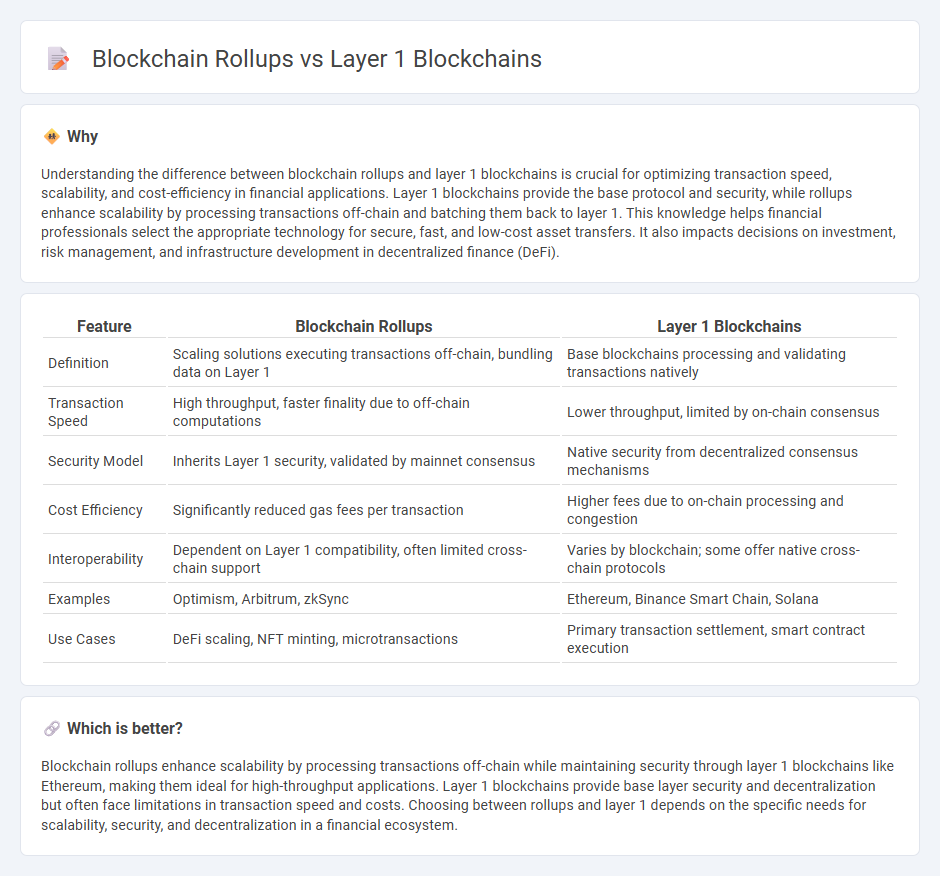
Blockchain rollups improve scalability by processing transactions off-chain while relying on layer 1 blockchains for security and final settlement. Layer 1 blockchains like Ethereum and Bitcoin handle consensus and data availability, but often face limitations in transaction throughput and high fees. Explore the benefits and trade-offs of rollups versus layer 1 blockchains to optimize decentralized applications.
Why it is important
Understanding the difference between blockchain rollups and layer 1 blockchains is crucial for optimizing transaction speed, scalability, and cost-efficiency in financial applications. Layer 1 blockchains provide the base protocol and security, while rollups enhance scalability by processing transactions off-chain and batching them back to layer 1. This knowledge helps financial professionals select the appropriate technology for secure, fast, and low-cost asset transfers. It also impacts decisions on investment, risk management, and infrastructure development in decentralized finance (DeFi).
Comparison Table
| Feature | Blockchain Rollups | Layer 1 Blockchains |
|---|---|---|
| Definition | Scaling solutions executing transactions off-chain, bundling data on Layer 1 | Base blockchains processing and validating transactions natively |
| Transaction Speed | High throughput, faster finality due to off-chain computations | Lower throughput, limited by on-chain consensus |
| Security Model | Inherits Layer 1 security, validated by mainnet consensus | Native security from decentralized consensus mechanisms |
| Cost Efficiency | Significantly reduced gas fees per transaction | Higher fees due to on-chain processing and congestion |
| Interoperability | Dependent on Layer 1 compatibility, often limited cross-chain support | Varies by blockchain; some offer native cross-chain protocols |
| Examples | Optimism, Arbitrum, zkSync | Ethereum, Binance Smart Chain, Solana |
| Use Cases | DeFi scaling, NFT minting, microtransactions | Primary transaction settlement, smart contract execution |
Which is better?
Blockchain rollups enhance scalability by processing transactions off-chain while maintaining security through layer 1 blockchains like Ethereum, making them ideal for high-throughput applications. Layer 1 blockchains provide base layer security and decentralization but often face limitations in transaction speed and costs. Choosing between rollups and layer 1 depends on the specific needs for scalability, security, and decentralization in a financial ecosystem.
Connection
Blockchain rollups enhance scalability by aggregating multiple transactions off-chain and submitting them to layer 1 blockchains, which serve as the security and consensus base layer. Layer 1 blockchains maintain decentralized validation, ensuring the integrity of rollup data while enabling higher throughput and lower costs. This connection allows rollups to offload transactional burden from layer 1, optimizing overall blockchain performance and user experience.
Key Terms
Consensus Mechanism
Layer 1 blockchains establish their own consensus mechanisms, such as Proof of Work (PoW) or Proof of Stake (PoS), enabling independent transaction validation and security directly on the base layer. Blockchain rollups operate on top of Layer 1 chains, leveraging the underlying consensus mechanism for finality while executing transactions off-chain to enhance scalability and reduce costs. Explore the technical distinctions and benefits of consensus architectures in blockchain ecosystems to deepen your understanding.
Scalability
Layer 1 blockchains provide a foundational protocol where all transactions are processed on-chain, often facing scalability limits due to consensus mechanisms and throughput constraints. Blockchain rollups operate as Layer 2 solutions that execute transactions off-chain and submit aggregated data to the Layer 1 chain, significantly enhancing transaction speeds and reducing gas fees while inheriting the security of the underlying blockchain. Explore detailed comparisons and scalability insights to understand which solution best fits your decentralized application needs.
Data Availability
Layer 1 blockchains maintain data availability on-chain, ensuring all transaction data is directly stored and accessible within the blockchain network, which enhances security and decentralization. Blockchain rollups, by contrast, bundle multiple transactions off-chain but publish compressed data on-chain to guarantee data availability while improving scalability and reducing transaction costs. Explore the trade-offs between data availability models to understand their impact on blockchain performance and security.
Source and External Links
Understanding Layer 1 Blockchains - Casper Network - Layer 1 blockchains are the main networks that independently validate and finalize transactions, providing the foundational infrastructure for decentralized applications and smart contracts, with examples including Bitcoin and Ethereum.
Layer-1 Coins - Top 50 List - Coinranking - Layer 1 blockchains create blocks through miners or validators who validate transactions using consensus mechanisms like sharding to improve scalability and security by processing multiple transactions in parallel across shards.
Layer 1 v. Layer 2 - Hedera - Layer 1 networks serve as the ultimate source of truth responsible for transaction settlement and maintain native tokens for paying network fees, while differing in consensus mechanisms balancing security, speed, and decentralization.
 dowidth.com
dowidth.com